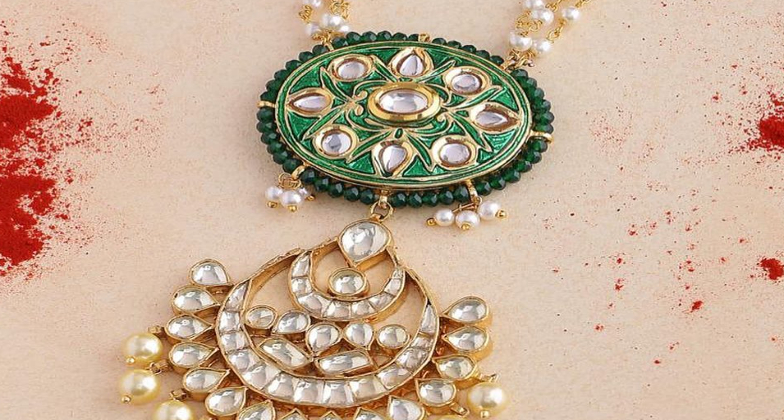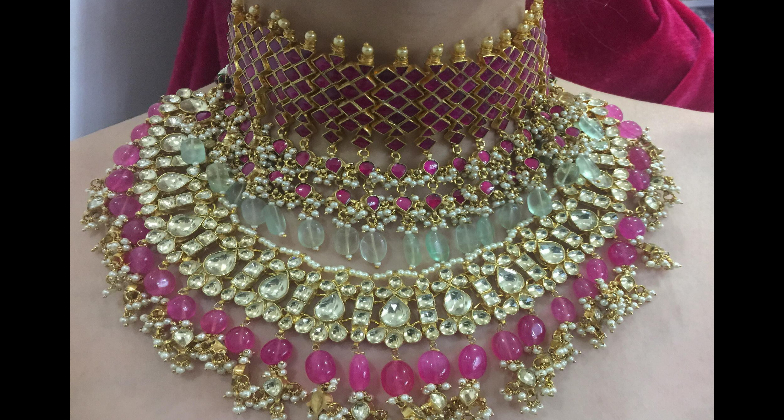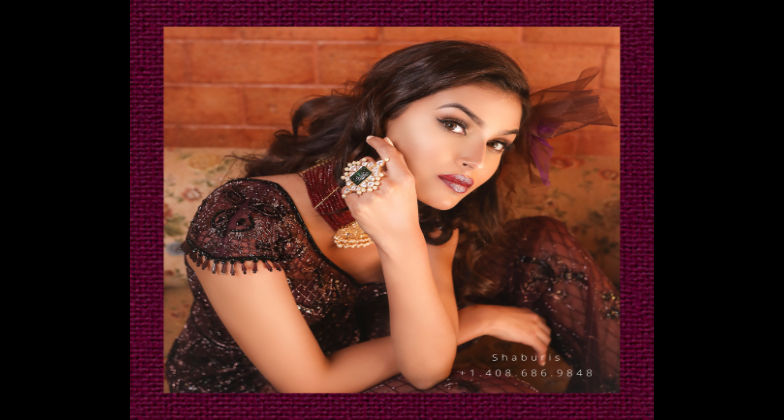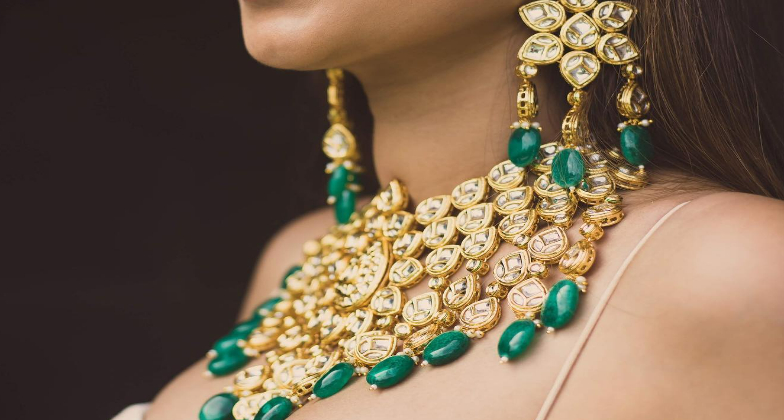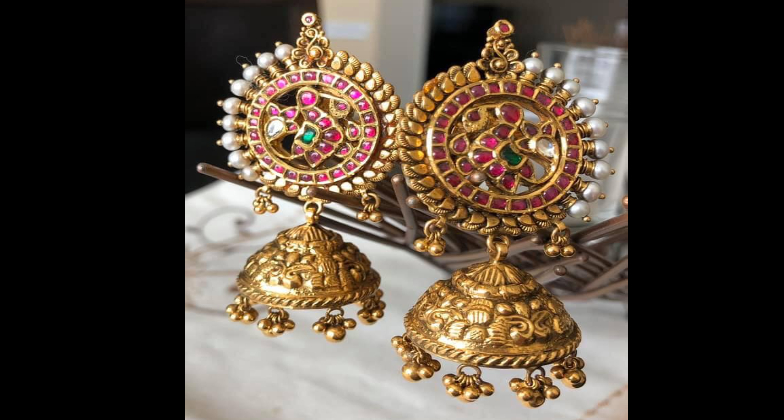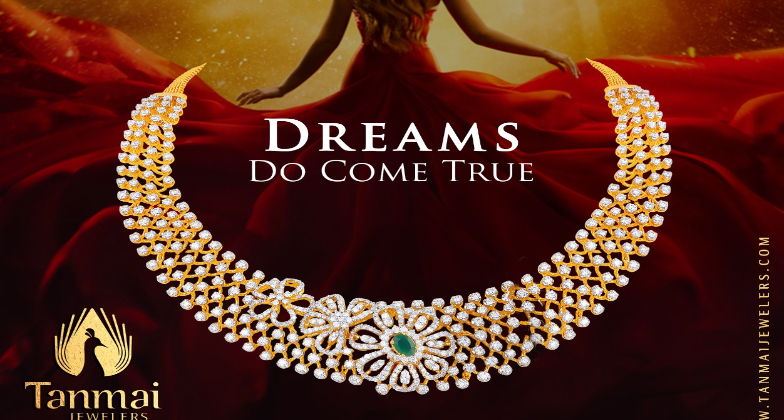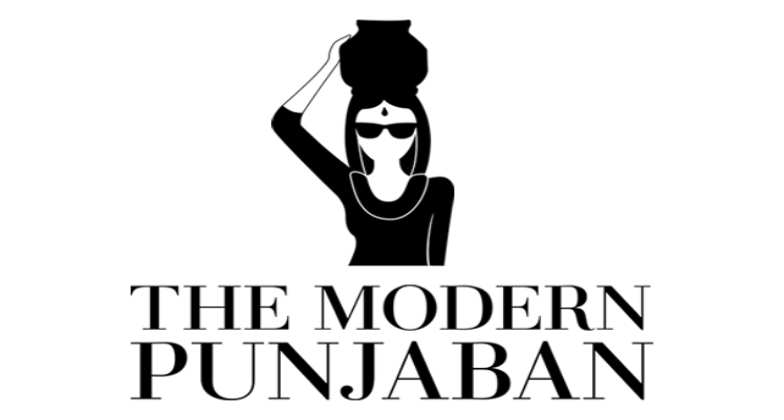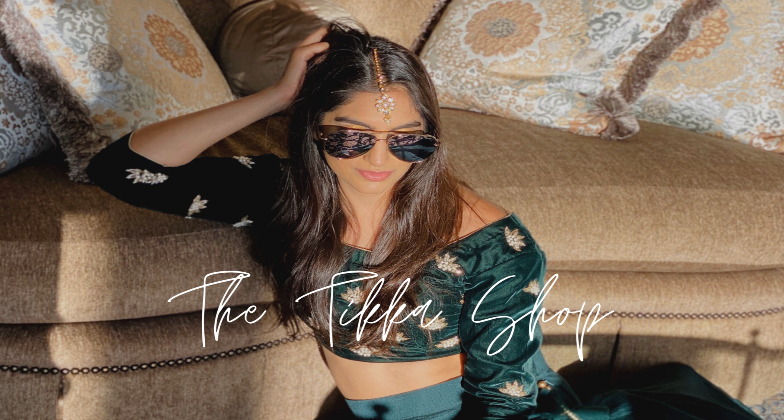Jewelry & Accessories
Top Desi Wedding Jewelry Vendors in Texas - Dallas, Houston, Austin
Your wedding jewelry complements and elevates your dream outfit. Whether it’s a trendy kundan choker or your must-have mangal sutra, your bridal accessories will be the cherry on top of your big-day look! The Desi Bride has curated Indian, Pakistani, and other South Asian jewelers and brands to provide you with the best wedding jewelry and accessory options.
Fun fact, did you know that many Indian brides, traditionally, followed 16 steps encompassing head-to-toe bridal adornments to transcend from being single to becoming married, a process called ‘solah shringar’? Historically, Indian queens would wear these 16 adornments to symbolize their marriage on their wedding day and whenever they made public appearances. You may recognize one or more of the 16 adornments below and that most of these are all about jewelry:
-
Bindi (dot on the forehead)
-
Sindoor (red powder applied where the bride parts her hair)
-
Kaajal or kohl (charcoal eyeliner)
-
Itraa or Ittar (perfume)
-
Shaadi (Suhaagan) ka Jodaa (wedding lehenga or saree)
-
Maang Teeka / Maatha Patti or Jhoomar: This accessory extends from the center parting until the bride’s forehead and has a centerpiece or pendant that rests on the forehead. Jhoomars are worn on the side of the head and include an A-line made of beads or pearls usually.
-
Nath (nose ring)
-
Haar: Typically a mangalsutra, this necklace of black and gold beads is an auspicious thread that symbolizes uniting two souls.
-
Karnphool / Jhumka / Chandbaali (earrings)
-
Choodiyaan (bangles)
-
Baajuband (armlet or bracelets worn on the upper part of the bride’s arm)
-
Aarsi evam haathphool: Hathphool is made of eight rings worn on all eight fingers, except the thumbs, and are joined to a hand centerpiece extending to a bangle or bracelet. Aarsi is a thumb ring, usually with a mirror on top.
-
Keshapasharachna: These are hair accessories for braids (billas) or buns (Raakodi / Jooda pins). Contemporary ornaments may include floral bun wraps, ornate combs, clips or barrettes with precious stones.
-
Kamarband (waistband)
-
Payal evam bichua (anklets and toe rings)
Bridal jewelry in South India:
-
Oddiyanam: Waist belt made of silver or gold
-
Kasu Mala: Traditional long necklace made of small coins
-
Manga Mala or Malai: Mango-shaped long necklace that goes until the bride’s navel and is made of paisley motifs
-
Metti: Toe ring made of silver with two or three rounds.
-
Vanki: Arm bands or armlets with intricate center pieces surrounded by carvings
-
Kolusu: Anklets made of silver
-
Mookkuthi: Nose studs worn on right side of the nostril or on both the sides.
-
Valaai or Valayal: Bangles made of glass, gold or silver
-
Jimikki or Jhimki: Earrings shaped like umbrella or inverted baskets
-
Thalaisamaan: Complete head jewelry set with maatha patti (strip worn on center hair parting), center piece or pendant that rests on the forehead and two hair brooches – one shaped like the sun and the other like moon.
-
Jadanagam: Hair jewelry used over the braid
-
Ungila: Gold rings worn in fingers
FAQ
What should I think about before buying Desi wedding jewelry?
-
Choose your jewelry to complement your face and outfits
-
Determine your (or your parents’) budget for jewelry. Remember that while you may purchase gold or diamond jewelry as a keepsake, there are so many, less expensive artificial jewelry options as well. You may go to a traditional Desi fine jeweler in Dallas or Houston, but you may also decide to go to a shop that sells artificial jewelry for your wedding jewelry shopping.
-
Be clear about what kind of jewelry you want or like: There are so many options in South Asian jewelry designs like ethnic, minimalistic or ornate, and even more options in style and materials like Polki, Kundan, Meena or platinum
-
Whether you choose to go with your family’s preferred jeweler in Texas or someone different, make sure they are a trusted partner and someone who will work with you to design the right jewelry set(s)
How can I make sure to match my jewelry with my bridal gown, saree or lehenga?
-
Match the colors and details of your outfit: If you are wearing a saree with zari or golden threadwork, then opt for a matching set in gold or platinum accordingly. A lehenga choli with white and green stones or beads may actually go better with fashion or costume jewelry in Kundan compared to a gold set, but sarees with bold golden borders such as Paithani sarees will look even more graceful with gold jewelry.
-
Reference your face shape: Your face shape can be a balancing factor while choosing wedding jewelry. While oval face shapes match most types of jewelry, square faces go well with chunky necklaces and heavy jhumkas. Finally, medium-length earrings with contemporary style necklace complement round faces.
-
Match your chooda or bangles with your bridal outfit: Whether you choose to wear pink, red, or maroon chooda should depend on the color of your wedding dress. Similarly, gold or glass bangles complement salwar-kameez and sharaara’s whereas chunky bangles or kadas may pair more elegantly with lehengas.
-
Contrast colors: Instead of going for red on red, opt for contrasting colors to make sure your accessories stand on their own. Think emerald on orange or green pearls on red. Alternatively, you pair gold and Kundan for a traditional look.
-
Consider necklines: Chokers go well with high necklines whereas wider necks pair well with heavy danglers. V-shaped necklines looked great with layered necklaces, and off-shoulder dresses or gowns look enticing with multi-colored neck pieces and a heavy-set maang teeka or jhoomar.
-
Minimalistic is always in: Same shade of jewelry and dress will draw attention to the face, so if you are looking for an all eyes on you, you can always opt for ivory or pastels with gold or silver in both your lehenga / saree and jewelry.
-
Diamonds never get old: If you are ready to dazzle, consider diamonds with gota patti. You can always pair diamonds with colored stones to match your lehenga or saree.
What are the different types of South Asian jewelry?
-
Fashion jewelry: Also known as costume, artificial, or faux jewelry, fashion jewelry is an inexpensive alternative and goes well with any contemporary outfit. It is not made up of any precious or semi-precious metal and is instead, made of nickel or brass with a light plating perhaps and synthetic stones. Given the lower cost and much larger variety in styles and colors, couples will often get 1-2 pieces of real jewelry and opt for costume jewelry to match a majority of their outfits.
-
Filigree jewelry: Ornate jewelry with beads and threads or wires molded to form artistic patterns or motifs, usually worn with traditional outfits especially long and flowing ones.
-
Kundan jewelry: Kundan in Sanskrit means pure gold. Kundan jewelry typically uses 24 karat gold foil between the mount and gemstones or other precious stones such as emeralds, rubies, diamonds, and pearls. It is an elaborate and layered creation.
-
Jadau jewelry: Jadau is the technique used for creating kundan or polki jewelry. In this creation, precious stones are embedded, engraved, and set in gold, handcrafted by artisans.
-
Meenakari: Meenakari includes painting with enamel in various colors. It comes from Gujarat and is often showcased on Kundan jewelry on the back of gemstones or painted intricately on the jewelry set.
-
Polki jewelry: Uncut or unfinished raw diamonds that are untouched by machines are used to create polki jewelry. The natural diamonds are placed with the help of gold foil.
-
Navratna jewelry: As the name suggests, this type of jewelry is made of nine gems representing the nine planets in Indian astrology. The nine gems include: Ruby or Manek for the sun, Pearl or Moti for the moon, Coral or Mangal for Mars, Emerald or Panna for Mercury, Yellow Sapphire or Pukhraj for Jupiter, Diamond or Heera for Venus, Blue Sapphire or Neelam for Saturn, Hessonite or Gomed for Rahu, Cat’s Eye or Lahsunya for Ketu.
What questions should I ask for custom order jewelry for Desi weddings?
-
How long will it take to receive the jewelry?
-
Will you be able to show us a sample of the jewelry piece before it is complete?
-
What is your policy in case the final design is different from what was ordered?
-
What is the price after taxes / VAT?
-
Will the cost vary while placing an order and after the completion?
-
What is your exchange and refund policy?
-
Do you create matching wedding bands or rings for the bride and groom? If yes then what material can I get them in – gold, diamond, titanium, silver? Many jewelers have contour or shadow bands that pair well with your rings. If you and your partner wish to have matching rings, it’s helpful to understand your options. You may decide to go with a Tiffany & Co with already matching wedding band options, or you may decide to work with a Tilak Jewellers or someone else to design matching wedding bands.
-
What would be the cost if I buy gold in India or take old jewelry and then have you turn it into a new jewelry piece? What are your labor charges? While gold has a special place in South Asian culture, it also has resale value and can be sold for cash in times of need.
-
What options do you have for ceremonies? Can I see some designs? In some cultures, the groom gives bridesmaids or bride’s sisters kaleechdi (silver or gold rings). In Punjabi weddings, the bride wears kaleerey tied on her chooda. Some jewelers will customize for all the rasam/rivaaz or ceremonies, so it’s better to understand your traditions and ask your jeweler what they can offer.
Should I travel to India to purchase my jewels?
Apart from the stones and gold, labor is one of the expensive components of authentic jewelry. Given that labor is much cheaper in India, if you are looking at price, then shopping for jewelry in India or jewelry in Pakistan may hurt your pocket a little less. With that said, many of the large jewelers have their designs made in India and are able to offer customization and services here in Texas, so you don’t have to travel far but can also take your time in making a decision and design your dream jewelry set or wedding bands with these wonderful brands.
What options of jewelry are there for Indian or Desi grooms?
-
Kalgi: A brooch on the groom’s safa or turban. A kalgi might include a serpent or gemstones.
-
Neck chain: A simple gold chain or a chain teamed with a pendant to complement the groom’s style. There are more stylish options like a double- or multi-layered necklaces stringed in kundan or pearls as well.
-
Bracelet or kadaa: An engraved or diamond-studded bracelet or a subtle platinum one
-
Cufflinks and lapel pins: Customized cufflinks or lapel pins in gold or silver-tone with the option to add diamonds if your groom loves bling
-
Buttons and brooches: Whether the groom opts for akurta, achkan, sherwani or tuxedo, buttons set in polki or diamonds can set the mood in an elegant way
Should I insure my wedding jewelry?
It depends on the cost of the jewelry and how likely you think you are to lose or damage it. Considering that thousands of dollars are spent on engagement rings alone, insurance is always a good-to-have. You can ask the jewelry store or your current home insurance about insuring jewelry. Often, wedding jewelry is covered in the renter’s and homeowner’s insurance policies. Make sure to check for the following:
-
What is the limit of the amount covered?
-
Is there a limit to the collective value of items?
-
Are circumstances such as loss and damage included?
-
Will you be subjected to a deductible before any amount is reimbursed to you?
What questions should I ask the jeweler before buying an engagement ring?
-
Which rings do you have available for custom-made versus immediate purchase? While you can always modify the ring later, labor is expensive, so it’s important to try to get it right the first time around. You should understand what you are looking for and whether the jeweler will require customization
-
What is your exchange policy?
-
Do you offer any warranty or services post-purchase? Some jewelers offer a lifetime warranty or servicing where they will polish the ring for years to come.
What types of engagement rings are trending for women in 2021?
For women, there are traditional, classic or vintage, minimalistic, and contemporary styles of engagement rings to choose from. Each style complements the personality of a woman, whether she is a go-getter who is not afraid to speak her mind or the one who oozes a quiet confidence. You can couple the stones with bands in platinum, white, yellow or rose gold for added accents. Here are a few styles to choose from:
-
Classic solitaire: The ‘one-big-diamond’ in the center ring is as classic as it is contemporary. The solitaire ring has been around since the late 19th century. Solitaire is best suited for those who prefer a classic, simple styles.
-
Princess cut ring: An emerald or square center stone daintily set in classic style
-
Double rings: A match of two rings sit together as if they were one ring
-
Halo ring: Designed with smaller diamonds surrounding a larger central stone to spell contemporary
-
Cushion cut: Rounded corners of a center stone surrounded by larger stones set in a vintage style
How should I take care of bridal or wedding jewelry?
-
Keep gold jewelry in satin or velvet cases or potlis (pouches). Make sure to keep each piece separately to prevent them from becoming entangled.
-
Keep Meenakari and silver jewelry in airtight plastic boxes
-
Apply makeup or perfume before wearing jewelry
-
Wrap Polki jewelry in cotton or wax paper and keep it in a silicon pouch in a cool, dry spot, away from direct sunlight
-
Polish your silver by cleaning it with vinegar and baking soda
-
Polish artificial jewelry with lemon juice or mild soap
What should I think about while buying a diamond ring or other diamond jewelry?
Diamonds have a charisma that is unparalleled. They sparkle bright and earn a place in your heart, forever! Here are a few tips to help you buy the right diamond engagement ring, bracelet, necklace, or even ‘build your own’ set without overpaying:
-
Select a shape: Diamonds come in all shapes: oval, pear, rectangular (emerald), heart, or round.
-
Prioritize 4Cs: Instead of solely focusing on the size of the diamond look at all 4 Cs – cut, color, clarity and carat. While carat is what most talk about, the reality is that the other 3 C’s are just as important. The cut will actually dictate how “sparkly” the diamond is. There is a tradeoff in cost, so you may decide to go for a slightly lower carat diamond but higher clarity – understand what is important and look beyond just the carat. In general, diamonds should have a clarity grade of VS1 or VS2. Pro tip: A diamond should appear colorless (range of G to I on the GIA color scale) when you see it in person.
-
The setting of diamond matters: If you opt for an elevated setting like solitaires have, the diamond will look bigger, whereas if you choose a depressed setting, the diamond will actually look smaller.
-
Choose the carat weight: Traditionally, the carat weight for an engagement ring averages between 1.0 to 1.2 carats. Here, you will want to visit the 4C’s and determine whether you opt for a large carat or a different cut or clarity instead.
-
Reference the diamond grading report: A diamond grading report will give you the exact characteristics of the diamond and whether it has been specially treated to enhance the color or clarity. In short, the report gives you a surety of the diamond’s authenticity and source. Also, if you are planning to get your diamonds insured, then the report is important to have on hand.
-
Budget: Recently, in the U.S., the average engagement ring has cost $5,000 upwards.
Should I buy an engagement ring online or in-store?
Purchasing diamonds online
-
Pros: Diamonds purchased online can be almost 40-50% cheaper at times as they don’t include all of the retail markups and operational costs you will find in store
-
Cons: If you buy online, it’s important to make sure you purchase from a reputed vendor like Blue Nile and that you have accurate sizing and know exactly what you will be getting.
Purchasing diamonds from in-store
-
Pros: If you work with a brick & mortar retailer, you are able to pick and choose, try on, and make sure the ring size is accurate.
-
Cons: In-store rings are more expensive given all of the add on operational costs like rent, salaries, and inventory costs.
Bottom line: Whether you’re buying online or on-site, make sure you purchase only high-quality, GIA or AGS certified diamonds. Also, even if you decide to purchase online, we recommend going to a couple of stores to try on rings and figure out the style and setting you prefer.
What are the options for men’s wedding bands?
-
Titanium: Titanium is known for its durability and resistance to scratches. It’s great for those who want to workout and work with their ring on at all times as it is somewhat scratch resistant and keeps its shape. It is hard to modify get to resized down the road, given its durability. It is also difficult to add stones, so the jeweler might add another mounting metal if you choose to add diamonds or gemstones.
-
Platinum: Like titanium, platinum is also a hypoallergenic metal. It’s significantly more expensive and is known for its beauty and luster. It’s a softer metal and allows for engraving and modifications, but this means you may also get scratches and wear and tear.
-
White gold ring: White gold is a common favorite. It lower priced compared to platinum but also less durable. Additionally, white gold, over time will show its yellow properties and will need to be repolished every year or two.
-
Rose gold band: An engraved or textured rose gold ring is a new trend we are seeing on grooms.
-
Gemstone ring: Finally, some cultures pride themselves on having the groom wear a center band with gemstones or birthstones. These stones can be set in white or yellow gold or a different alloy as well.
Who are the top South Asian wedding jewelry shops in Texas?
Click the below links to find your wedding jewelry set.
